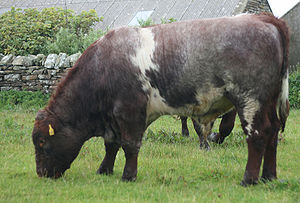
Beef Shorthorn
Encyclopedia

Cattle
Cattle are the most common type of large domesticated ungulates. They are a prominent modern member of the subfamily Bovinae, are the most widespread species of the genus Bos, and are most commonly classified collectively as Bos primigenius...
was developed from the Shorthorn
Shorthorn
The Shorthorn breed of cattle originated in the North East of England in the late 18th century. The breed was developed as dual purpose, suitable for both dairy and beef production; however there were always certain blood lines within the breed which emphasised one quality or the other...
breed in England and Scotland in around 1820. The Shorthorn was originally developed as a dual purpose breed, suitable for both dairy
Dairy cattle
Dairy cattle are cattle cows bred for the ability to produce large quantities of milk, from which dairy products are made. Dairy cows generally are of the species Bos taurus....
and beef
Beef cattle
Beef cattle are cattle raised for meat production . The meat of cattle is known as beef. When raised in a feedlot cattle are known as feeder cattle. Many such feeder cattle are born in cow-calf operations specifically designed to produce beef calves...
production. However different breeders opted to concentrate on one purpose rather than the other, and in 1958 the beef breeders started their own section of the herdbook. Since then the Beef Shorthorns have been developed as a separate breed to the Dairy Shorthorns
Milking Shorthorn
The Milking Shorthorn or Dairy Shorthorn is a breed of dairy cattle that originated in Great Britain. It developed from the Shorthorn, which itself came from County Durham, Northumberland and Yorkshire in north eastern England....
.
By the early 1970s the Beef Shorthorn breeders were concerned that their cattle were too small and lacked muscle
Muscle
Muscle is a contractile tissue of animals and is derived from the mesodermal layer of embryonic germ cells. Muscle cells contain contractile filaments that move past each other and change the size of the cell. They are classified as skeletal, cardiac, or smooth muscles. Their function is to...
, especially when compared with the continental breeds of cattle - like the Charolais
Charolais cattle
Charolais cattle are a beef breed of cattle which originated in Charolais, around Charolles, in France. They are raised for their meat and are known for their composite qualities when crossed with other breeds, most notably Angus and Hereford cattle...
or Limousin
Limousin (cattle)
Limousin cattle are a breed of highly muscled beef cattle originating from the Limousin and Marche regions of France. The breed is known as Limousine in France. Limousins were first exported from France in significant numbers in the 1960s and are now present in about 70 countries...
- that were starting to be introduced to the UK. To help remedy this, in 1976 the Beef Shorthorn Cattle Society sanctioned the introduction of Maine-Anjou blood into the breed. The Maine-Anjou breed was developed in France
France
The French Republic , The French Republic , The French Republic , (commonly known as France , is a unitary semi-presidential republic in Western Europe with several overseas territories and islands located on other continents and in the Indian, Pacific, and Atlantic oceans. Metropolitan France...
, and was descended from the same Durham cattle as the Shorthorn had been developed from. The decision to introduce Maine-Anjou blood into the Beef Shorthorn breed was very controversial at the time, however most breeders now acknowledge that it was a necessary step which saved the breed from irrelevance. The herd book was closed to Maine-Anjou blood lines in 2001, except by introduction through the Grading Register.
The Beef Shorthorn breed is not considered at risk by the Rare Breeds Survival Trust
Rare Breeds Survival Trust
The Rare Breeds Survival Trust is a conservation charity, whose purpose is to secure the continued existence and viability of the United Kingdom’s native farm animal genetic resources...
since there are more than 1,500 registered breeding females in the United Kingdom
United Kingdom
The United Kingdom of Great Britain and Northern IrelandIn the United Kingdom and Dependencies, other languages have been officially recognised as legitimate autochthonous languages under the European Charter for Regional or Minority Languages...
.

